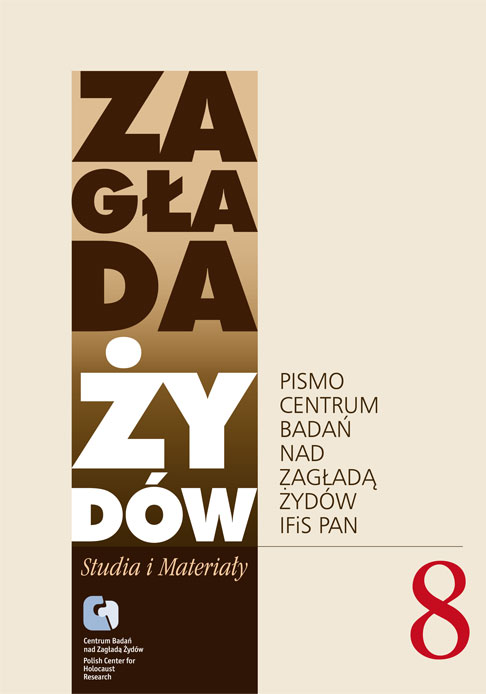O tym, co minęło, lecz nie zostało zapomniane: Badania archeologiczne na terenie byłego obozu zagłady w Treblince
Zagłada Żydów. Studia i Materiały, Nr 8 (2012), Strony: 83-118
Data zgłoszenia: 2020-10-27Data publikacji: 2012-12-02
 https://doi.org/10.32927/ZZSiM.628
https://doi.org/10.32927/ZZSiM.628
Abstrakt
Public impression of the Holocaust is unquestionably centred on knowledge about, and the image of, Auschwitz-Birkenau – the gas chambers, the crematoria, the systematic and industrialized killing of victims. Conversely, knowledge of the former extermination camp at Treblinka, which stands in stark contrast in terms of the visible evidence that survives pertaining to it, is less embedded in general public consciousness. As this paper argues, the contrasting level of knowledge about Auschwitz- Birkenau and Treblinka is centred upon the belief that physical evidence of the camps only survives when it is visible and above-ground. The perception of Treblinka as having been “destroyed” by the Nazis, and the belief that the bodies of all of the victims were cremated without trace, has resulted in a lack of investigation aimed at answering questions about the extent and nature of the camp, and the locations of mass graves and cremation pits. This paper discusses the evidence that demonstrates that traces of the camp do survive. It outlines how archival research and non-invasive archaeological survey has been used to re-evaluate the physical evidence pertaining to Treblinka in a way that respects Jewish Halacha Law. As well as facilitating spatial and temporal analysis of the former extermination camp, this survey has also revealed information about the cultural memory.
Słowa kluczowe
Treblinka , archeologia Zagłady , obóz zagłady , dowody rzeczowe , halacha
Licencja
Prawa autorskie (c) 2012 Autor&"Zagłada Żydów. Studia i Materiały"

Utwór dostępny jest na licencji Creative Commons Uznanie autorstwa 4.0 Międzynarodowe.
https://creativecommons.org/licenses/by/4.0
Czasopismo publikowane jest w standardzie Diamond Open Access na licencji CC-BY-4.0 Deed - Uznanie autorstwa 4.0 Międzynarodowa - Creative Commons
Inne teksty tego samego autora
- Caroline Sturdy Colls, Gone but not Forgotten: Archaeological approaches to the site of the former Treblinka Extermination Camp in Poland , Zagłada Żydów. Studia i Materiały: Nr Holocaust Studies and Materials (2013)
Podobne artykuły
- [Łucja Pawlicka-Nowak], Monika Polit, Relacja Mordechaja Żurawskiego z Chełmna nad Nerem [oprac. [Łucja Pawlicka-Nowak], Monika Polit, tłum. Monika Polit, Anna Styczyńska, Miłosz Omietoński] , Zagłada Żydów. Studia i Materiały: Nr 16 (2020)
- Sylweriusz B. Królak, Spacerem po getcie. Doświadczenie przestrzeni getta w Łodzi i w Warszawie z perspektywy pieszego , Zagłada Żydów. Studia i Materiały: Nr 16 (2020)
- Adriana Bryk, „Najlepsze dziecko Prezesa” – poczta w getcie łódzkim (1939–1944) , Zagłada Żydów. Studia i Materiały: Nr 16 (2020)
- Joanna Tokarska-Bakir, Przedziały śmierci. O książce Jana Grabowskiego, "Na posterunku. Udział polskiej policji granatowej i kryminalnej w zagładzie Żydów" , Zagłada Żydów. Studia i Materiały: Nr 16 (2020)
- Justyna Kowalska-Leder, „Coraz to nowe żądania, coraz to nowe grymasy” – relacja władzy i podporządkowania między Polakami a Żydami w kryjówkach po aryjskiej stronie , Zagłada Żydów. Studia i Materiały: Nr 12 (2016)
- Alicja Podbielska, Toruńskie Yad Vashem , Zagłada Żydów. Studia i Materiały: Nr 16 (2020)
- Redakcja, Ewa Wiatr, Adam Sitarek, Od Redakcji , Zagłada Żydów. Studia i Materiały: Nr 16 (2020)
- Wendy Lower, Sprawcy i sprawczynie Zagłady a podejście do sprawiedliwości w NRD w latach 1949–1963 , Zagłada Żydów. Studia i Materiały: Nr 8 (2012)
- Mordechay Giloh, Odmienne sylwetki przybyłych do Szwecji więźniów pochodzenia żydowskiego i nieżydowskiego, ocalałych z obozów koncentracyjnych na ziemiach polskich , Zagłada Żydów. Studia i Materiały: Nr 8 (2012)
- Jan Grabowski, Hunting down Emanuel Ringelblum. The Participation of the Polish Kriminalpolizei in the ‘Final Solution of the Jewish Question , Zagłada Żydów. Studia i Materiały: Nr Holocaust Studies and Materials (2017)
<< < 1 2 3 4 5 6 7 8 9 10 11 12 13 14 15 16 17 18 19 20 21 22 23 24 25 26 27 28 29 30 31 32 33 34 35 36 37 38 39 40 41 42 > >>
Możesz również Rozpocznij zaawansowane wyszukiwanie podobieństw dla tego artykułu.
 English
English
 Język Polski
Język Polski



 https://orcid.org/0000-0003-2942-6219
https://orcid.org/0000-0003-2942-6219

